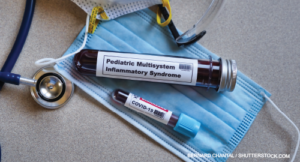 During the peak of the coronavirus pandemic in Washington, D.C., we were asked to evaluate a 14-year-old boy admitted to the pediatric hospitalist service. He had been healthy until two weeks before, when he noted a sore throat, and soon after he developed fevers and rashes without congestion, shortness of breath, conjunctivitis or swollen lymph nodes.
During the peak of the coronavirus pandemic in Washington, D.C., we were asked to evaluate a 14-year-old boy admitted to the pediatric hospitalist service. He had been healthy until two weeks before, when he noted a sore throat, and soon after he developed fevers and rashes without congestion, shortness of breath, conjunctivitis or swollen lymph nodes.
He was evaluated by his pediatrician, and the initial evaluation revealed abnormal inflammatory markers, including leukocytosis, elevated erythrocyte sedimentation rate (ESR) and C-reactive protein (CRP), a normal platelet count and normocytic anemia. Ferritin was markedly elevated at 5,200, and D-dimer exceeded the upper limits of the test. N-terminal-pro hormone B-type natriuretic peptide (NT-proBNP) and troponin tests were negative. SARS-CoV-2 IgG and polymerase chain reaction (PCR) tests were negative, although at the time of presentation, community spread of COVID-19 was high.
Later, in the emergency department, he was febrile and tachycardic, but did not appear acutely ill. Given the possibility of multisystem inflammatory disease in children (MIS-C), he was admitted for further observation.
Although the patient’s overall clinical impression was reassuring, the prolonged fevers, evidence of multisystem involvement with rashes, hematologic findings and elevated inflammatory markers were suggestive of MIS-C. However, findings that weren’t consistent with MIS-C, such as the duration of fever, uncertainty about the patient’s SARS-CoV-2 exposure, the highly elevated ferritin, as well as the initial complaint of cough two weeks prior to his hospitalization, all raised the possibility of an alternative diagnosis.
As pediatric rheumatologists practicing during the COVID-19 pandemic, we all have likely faced similar cases in which patients appear to fit the case definition of MIS-C, but the symptoms and lab findings are not clear-cut.
The Global Burden of MIS-C
MIS-C, a hyperinflammatory condition recognized initially in the U.K., is broadly characterized by fever, multi-organ dysfunction, elevated inflammatory markers, evidence of recent SARS-CoV-2 infection and reasonable exclusion of alternative diagnoses (see Table 1).1
Although causal evidence is lacking, it is widely presumed that MIS-C-associated inflammation is likely a late manifestation of prior SARS-CoV-2 infection that is clearly distinct from primary SARS-CoV-2 infection. Although a relatively low incidence of MIS-C in the U.S. of ~316 cases per 1 million infections is reported, up to 80% of patients may require intensive care unit (ICU) level care due to cardiac abnormalities, and 2% may die.2,3
With the recent emergence of MIS-C and its recognition as a clinical entity, our understanding of the condition is still in its infancy. Physicians have relied on case definitions set forth by the Centers for Disease Control and Prevention (CDC) and the World Health Organization (WHO).4
The uncertainties about what MIS-C is and the pathophysiology that initiates and perpetuates the uncontrolled inflammation have provided a diagnostic and therapeutic challenge to practicing pediatric rheumatologists.
Further, even though the current case definitions set forth by the CDC and WHO are deliberately broad so that MIS-C is not missed, the clinical expertise of frontline providers is needed to interpret the available information to make the correct diagnosis. Based on new information we have learned since MIS-C was officially recognized, can we refine our clinical and diagnostic framework of MIS-C to identify patients sooner and more definitively?
Refining the Clinical Entity of MIS-C
Using the CDC case definition as a guide, we can build on our current framework for MIS-C with established observations published since the condition’s emergence in 2019.
1 – Patients younger than 21 years old with fever greater than 38°C for more than 24 hours
In contrast to patients with Kawasaki disease, who are typically under 5 years old, children diagnosed with MIS-C are older, typically 4–13 years old; however, one-third of patients diagnosed with MIS-C are 5 years old or under.5 When compared with benign pediatric febrile illnesses in outpatient settings, patients with MIS-C typically have higher documented fevers, around 40°C, averaging five days in duration before medical attention is sought.6
Our patient’s age was not classic for Kawasaki disease, and his duration of fever was considerably longer than what is observed for a benign febrile illness, suggesting a concerning inflammatory condition, such as MIS-C.
2 – Evidence of multisystem involvement
It is now appreciated that MIS-C is a clinically heterogeneous inflammatory disease that includes at least three phenotypic subtypes: 1) cardiovascular (CV) or toxic shock-predominant disease; 2) Kawasaki disease-like features; and 3) non-specific inflammatory symptoms without overt shock or Kawasaki disease-like features.1,7
With the recent emergence of MIS-C & its recognition as a clinical entity, our understanding of this condition is still in its infancy.
Given these diverse presentations, MIS-C can also be described as a spectrum of disease severity, with CV shock representing severe illness due to the high likelihood of requiring ICU level of care, and Kawasaki disease-like and non-specific inflammation as moderate and mild illness, respectively.8
Certain organ systems are more likely to be affected in MIS-C than others. For example, cardiac, gastrointestinal, hematologic, mucocutaneous, respiratory and musculoskeletal involvement are frequent in more than half of MIS-C patients, and renal or neurologic involvement is less uncommon.9,10
The majority of patients present with at least three organ systems involved, and roughly one-third of patients present with clinical features and laboratory findings consistent with Kawasaki disease.9 Non-specific symptoms, including myalgias, nausea/vomiting and cough, are common in MIS-C. Not surprisingly, the presence of clinical symptoms of Kawasaki disease, such as conjunctivitis, extremity changes, rashes and mucocutaneous lesions, help differentiate MIS-C from other benign febrile illnesses.6
Cardiac Dysfunction in MIS-C
Unfortunately, MIS-C-related cardiac abnormalities are too common, including cardiogenic shock, electrocardiogram alterations, myocardial dysfunction and coronary artery dilation. Although the vast majority of children recover within a few days and death is rare, early recognition of cardiac inflammation is critically important because MIS-C patients with cardiac involvement may require ICU admission and inotropic support.3
Evaluation of MIS-C patients through various modalities, including cardiac magnetic resonance imaging and endomyocardial biopsy, has clearly demonstrated cardiac inflammation, suggesting that features of myocarditis and large vessel vasculitis underlie the cardiac dysfunction in MIS-C.11,12
In contrast to MIS-C-related CV shock, which correlates with disease severity, coronary aneurysms may be found in patients diagnosed with MIS-C who have no Kawasaki-like disease features, indicating that MIS-C-associated aneurysms do not correlate with clinical severity.9
The frequency of cardiac inflammation occurring in the absence of symptomatic heart failure is not clear, although a recent study demonstrated many MIS-C patients with normal ejection fractions have echocardiographic findings suggestive of asymptomatic myocardial injury.13 Reassuringly, reduced ejection fraction without abnormal BNP or troponin has not been reported.14
Thrombosis and neurologic complications are uncommon, but are associated with a high mortality rate.
Although uncommon, thrombosis is found in a minority of MIS-C patients, indicating an increased risk.15 MIS-C patients who are older than 12 years, have a history of malignancy or have a central venous catheter are at higher risk of thrombotic complications, including death. Similarly, severe neurologic symptoms of MIS-C, which may include stroke, encephalopathy, demyelinating disease and cerebral edema, are exceedingly rare but carry a high risk of mortality.16
Although our patient had evidence of mucocutaneous symptoms and anemia suggestive of multisystem involvement, he did not exhibit overt features of Kawasaki disease or CV shock concerning for MIS-C-related cardiac dysfunction, which was consistent with his normal NT-proBNP and troponin.
Table 1: The CDC Case Definition for MIS-C
• Patients less than 21 years old presenting with fever ≥38°C and ≥24 hours
AND
• Evidence of multisystem (≥2) organ involvement (cardiac, renal, respiratory, hematologic, gastrointestinal, dermatologic or neurologic)
AND
• Laboratory evidence of inflammation (including, but not limited to ≥1 of the following: elevated CRP, ESR, fibrinogen, procalcitonin, D-dimer, ferritin, LDH, or IL-6; elevated neutrophils; reduced lymphocytes; or low albumin
AND
• Positive for current or recent SARS-CoV-2 infection by PCR, serology, or antigen test, or exposure within 4 weeks prior to the onset of symptoms
AND
• No other plausible explanations
Adapted from https://www.cdc.gov/mis/index.html
3 – Laboratory evidence of inflammation
The current CDC case definition requires one or more objective finding of inflammation. Unfortunately, because inflammatory markers are non-specific, no single lab test is consistently elevated in all MIS-C patients. CRP is significantly elevated in the vast majority of confirmed MIS-C patients, but less so for other markers, such as ESR, ferritin and D-dimer.9
Additionally, because the significance of inflammatory markers including D-dimer and lactate dehydrogenase (LDH) in the context of MIS-C is not completely understood, the interpretation of these tests can sometimes be challenging.
Multiple observational studies have suggested that specific lab parameters may be useful for predicting MIS-C and distinguishing it from other inflammatory conditions. A recent meta-analysis suggests that when compared with non-severe COVID-19 patients, MIS-C patients have lower lymphocyte counts, LDH and platelets, and higher neutrophil counts, CRP and D-dimers. Further, elevated CRP and ferritin are associated with a higher odds of MIS-C.5
Objective lab findings have also been suggested to have clinical utility in discriminating disease severity related to MIS-C. For example, a recent study that sought to identify factors linked to severe outcomes in MIS-C found that lab findings, such as elevated D-dimer, troponin, BNP, CRP, ferritin, and interleukin-6 (IL-6) and decreased platelets and absolute lymphocytes, were associated with severe disease.5 Taken together, this information may provide clinicians with objective data to support a diagnosis of MIS-C and make evidence-based decisions to gauge disease severity and guide therapeutic decision making.
The uncertainties about what MIS-C is & the pathophysiology that initiates & perpetuates the uncontrolled inflammation have provided a diagnostic & therapeutic challenge to practicing pediatric rheumatologists.
Our patient’s inflammatory markers, such as CRP and ferritin, fulfilled the case definition of MIS-C, but his normal absolute lymphocyte and neutrophil counts were not consistent with the MIS-C literature and suggested an alternative diagnosis. Notably, although ferritin levels were elevated in roughly two-thirds of patients, they were not elevated to the extent as our patient’s.9
4 – Positive for current or recent SARS-CoV-2 infection by PCR, serology or antigen test, or exposure within four weeks prior to the onset of symptoms
The diagnosis of MIS-C depends on the attribution of inflammatory symptoms to a prior infection with SARS-CoV-2. Definitive symptoms of a prior SARS-CoV-2 infection are not reported in all patients, and it is suggested that MIS-C patients with the Kawasaki-like disease phenotype are more likely to not report a prior SARS-CoV-2 infection.
Additionally, a significant number of patients diagnosed with MIS-C do not have confirmatory PCR or serologies for SARS-CoV-2. For example, a recent meta-analysis showed that a significant proportion of patients did not exhibit objective evidence of previous SARS-CoV-2 infection, noting that about half of MIS-C patients were positive for SARS-CoV-2 by PCR test and roughly half of patients had positive COVID-19 serologies; another study estimated that COVID-19 serologies were negative in a quarter of patients labeled as MIS-C.17,18
The antibody response of children to COVID-19 is not well understood, but a recent study demonstrated that children produce SARS-CoV-2 antibodies of reduced breadth compared to adults, and they produce antibodies against S protein, but not N protein.19 Thus, it is proposed that children are able to clear COVID-19 infections more efficiently than adults due to a more robust innate immune response that makes a stronger antibody response unnecessary.
Based on these data, even though our patient’s SARS-CoV-2 IgG and PCR tests were both negative, the possibility of prior COVID-19 infection could not be formally excluded because negative serologies may be found in a quarter of MIS-C patients.
5 – No other plausible explanations

fizkes / shutterstock.com
To attribute a patient’s symptoms to MIS-C, it is imperative that alternative diagnoses be reasonably evaluated. Given the heterogeneity of MIS-C-related inflammatory symptoms, it is, therefore, not surprising that mimics of MIS-C have been reported in case reports highlighting the pitfalls and challenges clinicians have encountered. MIS-C has mimicked other inflammatory diseases, including Takayasu arteritis, appendicitis, bacterial and viral infections, malignancy and autoinflammatory diseases including systemic juvenile idiopathic arthritis.20,21
Comparisons of lab findings to understand the relationship between MIS-C-associated hyperinflammation and other conditions, such as macrophage activation syndrome and systemic juvenile idiopathic arthritis, may also aid in discriminating MIS-C. For example, T cell dysfunction and lymphopenia are consistent features of MIS-C and are proposed to underlie the pathogenesis of hyperinflammation.22
Further, a cytokine called interferon gamma (IFNγ) has been implicated in MIS-C-associated hyperinflammation; consequently, a chemokine called CXCL9, which is driven by IFNγ, is also significantly elevated in MIS-C.23,24 In contrast, IL-18, which is highly expressed in systemic juvenile idiopathic arthritis, is not significantly elevated in MIS-C.24
As the inflammatory pathways in MIS-C are unraveled further, it is a possibility that this information could be used for diagnostic purposes and to provide rationale for therapeutic targets.
In Sum
Although our patient met the demographics and case definition of MIS-C, his reassuring clinical appearance clinical appearance, duration of fever and lab findings notable for normal absolute lymphocyte count and a highly elevated ferritin suggested that we evaluate for alternative diagnoses, in particular systemic juvenile idiopathic arthritis and infection. Evaluation for common infectious processes was negative, but IL-18 was highly elevated.
Further, close outpatient follow-up revealed synovitis, providing additional support for a diagnosis of systemic juvenile idiopathic arthritis with subclinical macrophage activation syndrome. At present, the patient is doing well, and his disease is in remission on methotrexate and canakinumab.
Although more investigation is still needed to understand the pathogenesis and natural history of MIS-C, the information we have is clearly having a positive impact on our clinical abilities to distinguish MIS-C from other similar processes, which is critical because early recognition and treatment of MIS-C are associated with favorable patient outcomes.
Finally, accurate recognition and diagnosis of MIS-C may allow for the design of better studies to achieve a better understanding of how MIS-C fits among our other rheumatic conditions and to guide treatment.
 Brian L.P. Dizon, MD, PhD, is a National Institute of Arthritis and Musculoskeletal and Skin Diseases Metzger Scholar in the laboratory of Susan Pierce, PhD, at the National Institutes of Health, Bethesda, Md., where he studies the regulation of B cells in chronic inflammatory diseases in humans.
Brian L.P. Dizon, MD, PhD, is a National Institute of Arthritis and Musculoskeletal and Skin Diseases Metzger Scholar in the laboratory of Susan Pierce, PhD, at the National Institutes of Health, Bethesda, Md., where he studies the regulation of B cells in chronic inflammatory diseases in humans.
 Sangeeta Sule, MD, PhD, is chief of rheumatology at Children’s National Hospital, Washington, D.C., and associate professor at George Washington University School of Medicine and Health Sciences in Washington, D.C.
Sangeeta Sule, MD, PhD, is chief of rheumatology at Children’s National Hospital, Washington, D.C., and associate professor at George Washington University School of Medicine and Health Sciences in Washington, D.C.
Acknowledgments
This research was supported in part by the Intramural Research Program of the National Institute of Arthritis and Musculoskeletal and Skin Diseases of the National Institutes of Health.
References
- Riphagen S, Gomez X, Gonzalez-Martinez C, et al. Hyperinflammatory shock in children during COVID-19 pandemic. Lancet. 2020 May 23;395(10237):1607–1608.
- Payne AB, Gilani Z, Godfred-Cato S, et al. Incidence of multisystem inflammatory syndrome in children among US persons infected with SARS-CoV-2. JAMA Netw Open. 2021 Jun 1;4(6):e2116420.
- Rodriguez-Gonzalez M, Castellano-Martinez A, Cascales-Poyatos HM, et al. Cardiovascular impact of COVID-19 with a focus on children: A systematic review. World J Clin Cases. 2020 Nov 6;8(21):5250–5283.
- Rafferty MS, Burrows H, Joseph JP, et al. Multisystem inflammatory syndrome in children (MIS-C) and the coronavirus pandemic: Current knowledge and implications for public health. J Infect Public Health. 2021 Apr;14(4):484–494.
- Abrams JY, Oster ME, Godfred-Cato SE, et al. Factors linked to severe outcomes in multisystem inflammatory syndrome in children (MIS-C) in the USA: A retrospective surveillance study. Lancet Child Adolesc Health. 2021 May;5(5):323–331.
- Carlin RF, Fischer AM, Pitkowsky Z, et al. Discriminating multisystem inflammatory syndrome in children requiring treatment from common febrile conditions in outpatient settings. J Pediatr. 2021 Feb;229:26–32.e2.
- Licciardi F, Pruccoli G, Denina M, et al. SARS-CoV-2-induced Kawasaki-like hyperinflammatory syndrome: A novel COVID phenotype in children. Pediatrics. 2020 Aug;146(2):e20201711.
- Corwin DJ, Sartori LF, Chiotos K, et al. Distinguishing multisystem inflammatory syndrome in children from Kawasaki disease and benign inflammatory illnesses in the SARS-CoV-2 pandemic. Pediatr Emerg Care. 2020 Nov;36(11):554–558.
- Feldstein LR, Rose EB, Horwitz SM, et al. Multisystem inflammatory syndrome in U.S. children and adolescents. N Engl J Med. 2020 Jul 23;383(4):334–346.
- Gruber CN, Patel RS, Trachtman R, et al. Mapping systemic inflammation and antibody responses in multisystem inflammatory syndrome in children (MIS-C). medRxiv. 2020 Jul 6;2020.07.04.20142752. Preprint.
- Blondiaux E, Parisot P, Redheuil A, et al. Cardiac MRI in children with multisystem inflammatory syndrome associated with COVID-19. Radiology. 2020 Dec:297(3):E283–E288.
- Bonnet M, Champagnac A, Lantelme P, et al. Endomyocardial biopsy findings in Kawasaki-like disease associated with SARS-CoV-2. Eur Heart J. 2020 Oct 14;41(39):3863–3864.
- Matsubara D, Kauffman HL, Wang Y, et al. Echocardiographic findings in pediatric multisystem inflammatory syndrome associated with COVID-19 in the United States. J Am Coll Cardiol. 2020 Oct 27;76(17):1947–1961.
- Kelly MS, Valle CW, Fernandes ND, et al. Multisystem inflammatory syndrome in children: Cardiac biomarker profiles and echocardiographic findings in the acute and recovery phases. J Am Soc Echocardiogr. 2020 Oct;33(10):1288–1290.
- Whitworth H, Sartain SE, Kumas R, et al. Rate of thrombosis in children and adolescents hospitalized with COVID-19 or MIS-C. Blood. 2021 Jul 15;138(2):190–198.
- LaRovere KL, Riggs BJ, Poussaint TY, et al. Neurologic involvement in children and adolescents hospitalized in the United States for COVID-19 or multisystem inflammatory syndrome. JAMA Neurol. 2021 May 1;78(5):536–547.
- Hoste L, Van Paemel R, Haerynck F. Multisystem inflammatory syndrome in children related to COVID-19: A systematic review. Eur J Pediatr. 2021 Jul;180(7):2019–2034.
- Dhar D, Dey T, Samim MM, et al. Systemic inflammatory syndrome in COVID-19-SISCoV study: Systematic review and meta-analysis. Pediatr Res. 2021 May 18;1–16.
- Weisberg SP, Connors TJ, Zhu Y, et al. Distinct antibody responses to SARS-CoV-2 in children and adults across the COVID-19 clinical spectrum. Nat Immunol. 2021 Jan;22(1):25–31.
- Qasim A, Kaushal S, Bansal M, et al. Echocardiographic clues in diagnosis of Takayasu arteritis in a child with SARS-CoV-2 related multisystem inflammatory syndrome. CASE (Phila). 2021 Aug;5(4):217–220.
- Roberts JE, Campbell JI, Gauvreau K, et al. Differentiating multisystem inflammatory syndrome in children: A single-centre retrospective cohort study. Arch Dis Child. 2022 Mar;107(3):e3.
- Consiglio CR, Cotugno N, Sardh F, et al. The immunology of multisystem inflammatory syndrome in children with COVID-19. Cell. 2020 Nov 12;183(4):968–981.e7.
- Diorio C, Shraim R, Vella LA, et al. Proteomic profiling of MIS-C patients reveals heterogeneity relating to interferon gamma dysregulation and vascular endothelial dysfunction. medRxiv. 2021 Apr 20;2021.04.13.21255439. Preprint.
- Rodriguez-Smith JJ, Verweyen EL, Clay GM, et al. Inflammatory biomarkers in COVID-19-associated multisystem inflammatory syndrome in children, Kawasaki disease, and macrophage activation syndrome: A cohort study. Lancet Rheumatol. 2021 Aug:3(8):e574–e584.



